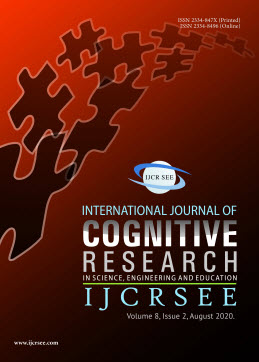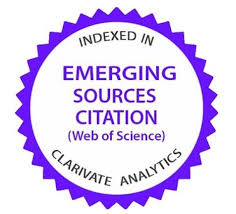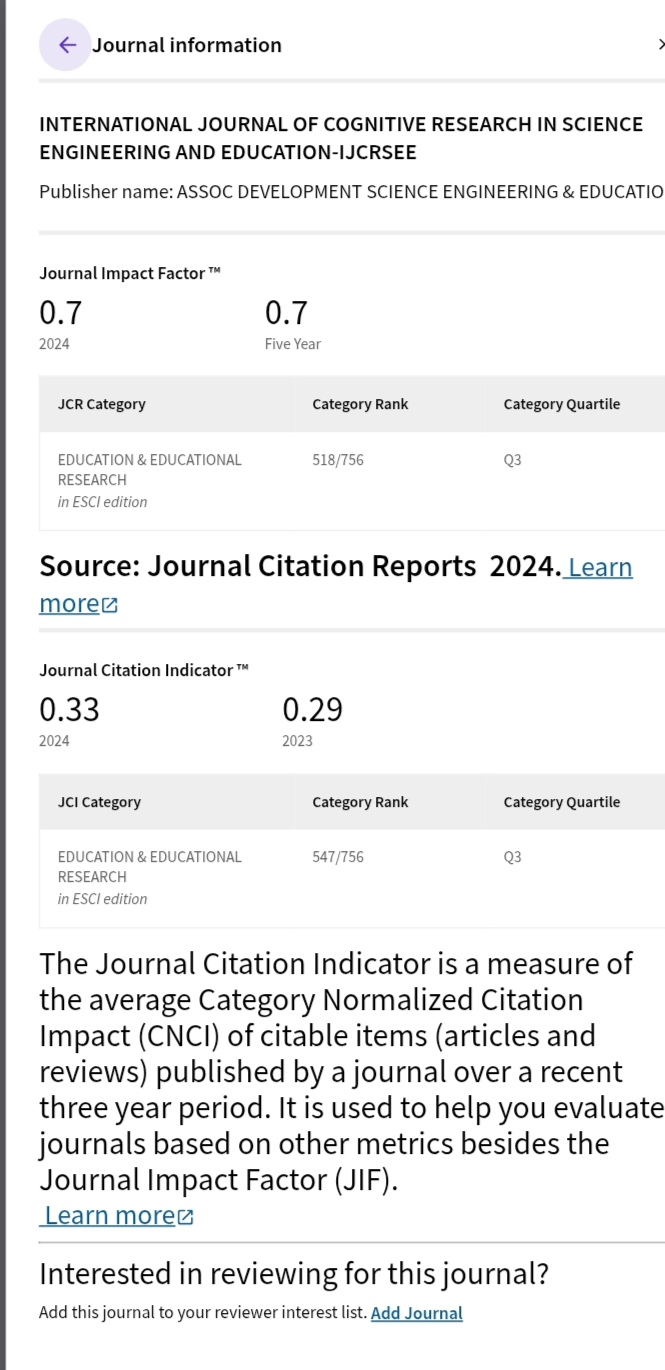GNOSTIC EMOTIONS OF STUDENTS IN SOLVING OF THINKING TASKS
DOI:
https://doi.org/10.5937/IJCRSEE2002027BKeywords:
emotion, gnostic emotions, emotional orientation, thinking, strategies for solving thinking problemsAbstract
The paper presents the results of an empirical study of the emotional characteristics of students when solving thinking problems. The study used an experiment that simulates a students’ collaborative solution to the puzzle-doing problem. To study emotional variables, we used the method of B.I. Dodonov for determination of the general emotional orientation. To investigate feelings experienced by students, we used the method of K. Isard. According to the authors, the following types of general emotional orientation (with decrease) are dominated among students: altruistic, communicative, and mixed types. All students showed the dominance of emotions of interest, joy and surprise under the decision processes, regardless of the emotional type of personali-ty. It was revealed that under the processes of solving thinking problems, students with the dominance of various types of emo-tional orientation showed a different ratio of emotions. Four strategies of solving thinking problems were identified, which are characterized by the representation of various emotions.
Downloads
References
Belousova A.K. (2002). Самоорганизация совместной мыслительной деятельности. [Collaborative Thinking Activity Self-Organization]. Ростов-на-Дону: РГПУ. Retrieved from: https://www.elibrary.ru/item.asp?id=23550556
Belousova A.K. (2010). Initiation of Collaborative Thinking Activity Self-Organization: Basic conceptions and experimental research of collaborative thinking activity generation. Saarbrücken: LAP LAMBERT. Retrieved from: https://www.morebooks.de/store/gb/book/initiation-of-collaborative-thinking-activity-self-organization/isbn/978-3-8433-7190-2
Belousova, A. K., & Belousova, E. E. (2016). Emotional characteristics of students during collaborative thinking activity. International Journal of Psychology, 51(S1), 540. Retrieved from: https://www.elibrary.ru/item.asp?id=27358330
Belousova, A.K., Pavlova, T.V. (2013). Features of communicative sphere of preschool children collaborative thinking activity. International Journal of Cognitive Research in Science, Engineering and Education. 1(1), 1-4. Retrieved from: https://ijcrsee.com/index.php/ijcrsee/article/view/218
Bless, H., & Fiedler, K. (1995). Affective states and the influence of activated general knowledge. Personality and Social Psychology Bulletin, 21(7), 766-778. https://doi.org/10.1177/0146167295217010
Clore, G. L., Schwarz, N., & Conway, M. (1994). Affective causes and consequences of social information processing. In R. S. Wyer & T. K. Srull (Eds.). Handbook of social cognition (pp. 323-417). Hillsdale, NJ: Erlbaum. Retrieved from: https://psycnet.apa.org/record/1994-97751-007
Dermanova, I.B. (2002). Диагностика эмоционально-нравственного развития. [Diagnosis of emotional and moral development]. Sankt-Petrburg: Rech’, 132-134. Retrieved from: https://www.books.ru/books/diagnostika-emotsionalno-nravstvennogo-razvitiya-40643/
Dodonov, B. I. (1978). Эмоция как ценность [Emotion as a Value]. Moscow: Politizdat Retrieved from: https://www.klex.ru/author/dodonov_b/
Ekman, P. (1992). An argument for basic emotions. Cognition and Emotion. 6(3-4), 169–200. https://doi.org/10.1080/02699939208411068
Eliseev, O.P. (2003). Практикум по психологии личности [Workshop on personality psychology]. Sankt-Petersburg: Rech’, 226-227. Retrieved from: https://www.klex.ru/627
Fiedler, K. (2001). Affective states trigger processes of assimilation and accommodation. In L. L. Martin & G. L. Clore (Eds.). Theories of mood and cognition: A user’s guidebook (pp. 85-98). Mahwah, NJ: Erlbaum. Retrieved from: https://psycnet.apa.org/record/2001-16267-004
Forgas, J. P. (2008). Affect and cognition. Perspectives on Psychological Science, 3(2), 94–101. https://doi.org/10.1111/j.1745-6916.2008.00067.x
Goldin, G. A. (2004). Problem solving heuristics, affect, and discrete mathematics. Zentralblatt für Didaktik der Mathematik 36, 56–60 https://doi.org/10.1007/BF02655759
Guntz, T., Crowley, J. L., Vaufreydaz, D., Balzarini, R., & Dessus, P. (2018, October). The role of emotion in problem solving: First results from observing chess. In Proceedings of the workshop on modeling cognitive processes from multimodal data (pp. 1-8). https://doi.org/10.1145/3279810.3279846
Hannula M. S. (2015) Emotions in Problem Solving. In: Cho S. (eds) Selected Regular Lectures from the 12th International Congress on Mathematical Education. Springer, Cham. https://doi.org/10.1007/978-3-319-17187-6_16
Hertel, G., Neuhof, J., Theuer, T., & Kerr, N. L. (2000). Mood effects on cooperation in small groups: Does positive mood simply lead to more cooperation?. Cognition & emotion, 14(4), 441-472. https://doi.org/10.1080/026999300402754
Isen, A. M., Daubman, K. A., & Nowicki, G. P. (1987). Positive affect facilitates creative problem solving. Journal of personality and social psychology, 52(6), 1122. https://doi.org/10.1037/0022-3514.52.6.1122
Izard, C. E. (1991). Emotions, personality, and psychotherapy. The psychology of emotions. Plenum Press. https://doi.org/10.1007/978-1-4899-0615-1
Klochko, V. E., Galazhinsky, E. V. (2000). Самореализация личности: системный взгляд. [Self-realization of personality: a systematic view]. Tomsk: Tomsk University Press. Retrieved from: http://vital.lib.tsu.ru/vital/access/manager/Repository/vtls:000112507
Michael, J. (2011). Shared emotions and joint action. Review of Philosophy and Psychology, 2(2), 355-373. https://doi.org/10.1007/s13164-011-0055-2
Nasledov, A. D. (2007). Математические методы психологического исследования. Анализ и интерпретация данных [Mathematical methods of psychological research. Analysis and interpretation of data]. Sankt-Petersburg: Rech’. Retrieved from: https://www.elibrary.ru/item.asp?id=20090155
Oatley, K., & Johnson-Laird, P. N. (1987). Towards a cognitive theory of emotions. Cognition and emotion, 1(1), https://doi.org/10.1080/02699938708408362
Pekrun, R., & Stephens, E. J. (2010). Achievement emotions: A control‐value approach. Social and Personality Psychology Compass, 4(4), 238-255. https://doi.org/10.1111/j.1751-9004.2010.00259.x
Salmela, M., & Nagatsu, M. (2016). Collective emotions and joint action: beyond received and minimalist approaches. Journal of Social Ontology, 2(1), 33-57. https://doi.org/10.1515/jso-2015-0020
Scherer, K. (2000). Psychological models of emotion. In Joan C. Borod (Ed.) The neuro-psychology of emotion. Oxford University Press. Retrieved from: https://global.oup.com/academic/product/the-neuropsychology-of-emotion-9780195114645?cc=us&lang=en&
Schwarz, N. (2000). Emotion, cognition, and decision making. Cognition & Emotion, 14(4), 433-440. https://doi.org/10.1080/026999300402745
Spering, M., Wagener, D., Funke, J. (2005) The role of emotions in complex problem-solving. Cognition and Emotion. 19(8), 1252-1261. https://doi.org/10.11588/heidok.00008252
Tikhomirov, O. K. (2008). Психология мышления. [The psychology of thinking]. Moscow: Academy. Retrieved from: https://elibrary.ru/author_items.asp?authorid=71844&show_refs=1&show_option=1
Vasiliev I. A., Popluzhny V. L., Tikhomirov O. K. (1980). Эмоции и мышление [Emotions and thinking]. Moscow: Moscow University Press. Retrieved from: https://search.rsl.ru/ru/record/01000996416
Zinck, A., & Newen, A. (2008). Classifying emotion: a developmental account. Synthese, 161(1), 1-25. https://doi.org/10.1007/s11229-006-9149-2
Published
How to Cite
Issue
Section
Categories
License
Copyright (c) 2020 by the authors

This work is licensed under a Creative Commons Attribution 4.0 International License.











